203 series facts for kids
Quick facts for kids 203 series |
|
|---|---|
 |
|
| In service | 1982-2011 (Japan) 2011-now (Indonesia) 2012-now (Philipines) |
| Specifications | |
| Track gauge | 1,067mm |
The 203 series is a special type of train called an Electric multiple unit (EMU). This means it's a train made of several connected cars that all have their own motors. They don't need a separate engine car to pull them. These trains were first used in Japan from 1982 to 2011. After that, they got a new life! Many of them were sent to Indonesia and the Philippines, where they are still used today to carry lots of passengers.
Contents
Meet the 203 Series Train
The 203 series trains were built in Japan starting in 1982. They were designed to run on specific train lines, like the Jōban Line and the Chiyoda Line in Tokyo. These trains were very important for daily commutes, helping thousands of people get to work and school.
The trains were known for being reliable and efficient. They had special motors that helped them run smoothly. Each train set usually had 10 cars, allowing them to carry many people at once.
From Japan to New Homes
After nearly 30 years of service in Japan, the 203 series trains were retired. This happens when newer, more modern trains are built to take their place. However, these trains were still in good condition. Instead of being scrapped, many of them were given a second chance.
Starting in 2011, several 203 series train sets were sent to Indonesia. In 2012, some were also sent to the Philippines. This was a great way to reuse trains and help other countries improve their public transportation.
Life in Indonesia and the Philippines
In Indonesia, the 203 series trains are used by Kereta Commuter Indonesia. They run on busy commuter lines around Jakarta, the capital city. These trains help millions of people travel every day. They are often seen with new paint schemes and sometimes have fewer cars than they did in Japan.
In the Philippines, the trains are operated by the Philippine National Railways (PNR). They serve lines in and around Manila, the capital. These trains are a key part of the public transport system there, helping to ease traffic congestion. The 203 series trains are still working hard, carrying passengers across different cities.
Gallery
Images for kids








